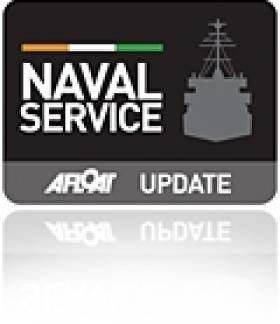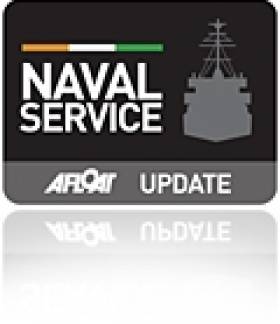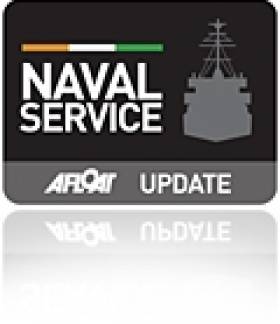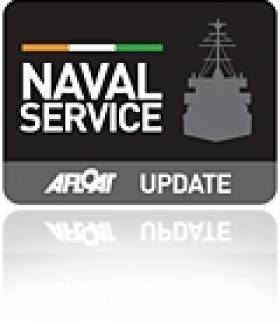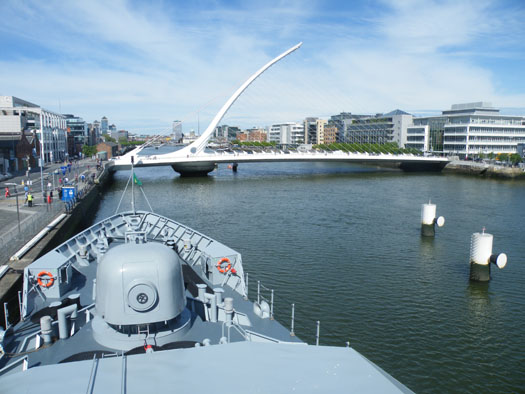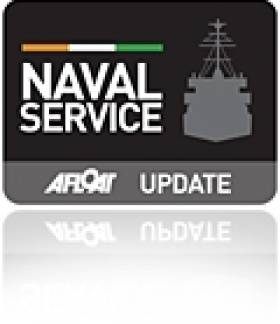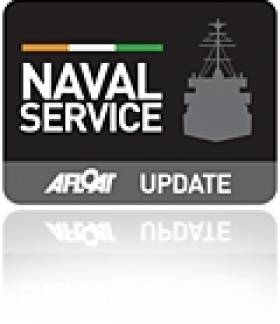Displaying items by tag: LE Samuel Beckett
Minister Coveney Commends Crew of LE Samuel Beckett for Humanitarian Role
#CrewCommended - On a visit to Malta yesterday, Minister for Defence Simon Coveney visited L.É. Samuel Beckett currently deployed in the Mediterranean on humanitarian search and rescue operations.
Earlier in the day, the Minister met with EU Commissioner Karmenu Vella to discuss key issues in relation to fisheries and the increasing potential of the blue economy to contribute to national recovery and to the wider EU economy.
In the afternoon, the Minister visited L.É. Samuel Beckett berthed in Valetta for resupply and met with the ship’s captain, Lieutenant Commander Anthony Geraghty, and members of the crew to review the ongoing operation and to commend the important work they are doing in addressing the humanitarian fallout from the migrant crisis in the central Mediterranean.
The Minister was accompanied on his visit by Assistant Secretary General Ciaran Murphy and the Chief of Staff of the Defence Forces, Vice Admiral Mark Mellett.
Speaking to the crew on deck of L.É. Samuel Beckett, the Minister said: “While the tempo of operations in this part of the Mediterranean may have declined somewhat in the past few weeks, we cannot become complacent. As the sea condition worsens, there is an increasing risk for all those who embark on the dangerous journey from North Africa to Europe. We must continue to be ever vigilant to their plight and continue to operate to the highest standards to ensure as far as is humanly possible that all those at risk in this sea are rescued.”
L.É. Samuel Beckett replaced L.É. Niamh at the end of September and will continue Ireland’s contribution to the search and rescue mission up to December 2015, subject to ongoing assessment of the crisis and the operational need to continue to provide such assistance.
The operation is being conducted in close coordination with the Italian authorities. The vessel will not be replaced on withdrawal but a review of the mission to date and consideration of possible further participation in operations in the Mediterranean next year will be evaluated over the coming months.
L.É. Samuel Beckett with a crew of 59 Naval Service personnel including 4 Defence Forces medics drawn from the Army, Navy and Air Corps is continuing the remarkable work started by L.É. Eithne and continued by L.É. Niamh.
To date, L.É. Samuel Beckett has rescued 562 men women and children, bringing the total rescued by Naval Service vessels to date to nearly 8,100.
Addressing the crew directly the Minister said: “The work of the Naval Service to date, here in the Mediterranean, stands as testament to what a small committed country can do if there is the political will to respond. It’s not about being large or small but about commitment to serve. You, the members of this ship’s company, stand witness to the tragedy unfolding here in the Mediterranean. Not alone do you mount important rescue operations and bring hope to those you rescue, but you also focus the continuing attention of Irish and international public opinion on this crisis. I have no doubt, but that in the best traditions of the Naval Service and of the Defence Forces you will continue to do your duty.”
Minister Coveney concluded “Migration is a major challenge confronting the EU and there are no easy answers. However, Ireland is committed to doing its part as a committed member of the Union in responding to that crisis. You are a key part of that national response and, on behalf of myself and the Irish Government, I would like to thank you all for your outstanding work in the Mediterranean to date. I wish you every success for the future and a safe return to your families.”
To Join Rescue Mission LÉ Samuel Beckett Heads to the Med
#Beckett2Med - Due to depart her base in Haulbowline, Co Cork, this morning, LÉ Samuel Beckett (P61) is to take over refugee rescue missions in the Mediterranean from LÉ Niamh.
According to The Irish Examiner, it’s expected that she will take a week to get to her area of operations between Sicily and Libya and prior to starting her mission, her 59-strong crew under the command of Lieutenant Commander Anthony Geraghty, will get a briefing from the Italian authorities in Sicily.
Meanwhile, LÉ Niamh’s crew have finished their mission and are currently enjoying some R&R in the Maltese capital Valletta.
Yesterday the crew hosted a reception for the Irish ambassador and they will depart for home on Saturday. Depending on weather she should arrive in Haulbowline on Friday, October 2.
Both ships will rendezvous somewhere near Gibraltar in the coming days, where some personnel and equipment will be transferred between them.
For much more on the refugee migrant crisis, click here.
Naval Service Exercise Demonstrates Multi-Task Roles for Newest and Oldest Patrol Vessels
#NavalExercises – The Naval Service's newest and oldest patrol vessels have taken part in a week-long major exercise, one of several held annually, where L.É Samuel Beckett (P61) set her paces accompanied by L.E. Aoife offshore of Cork Harbour, writes Jehan Ashmore.
In command of the €54m newbuild is Cdr. Ken Minihan who recently was promoted to the role of Officer in Charge of Fleet Operations, in which he will take this position in August. Cdr. Minihan has the responsibility of 43 crew and on occasions this can rise by a further 10 personnel.
Due to the overall requirements to recruit crew and that of the newbuild programme of a trio of OPV90 or 'Beckett' class, the new ships will feature additional berths to accommodate 10 cadet trainees.
According to Cdr. Minihan, the OPV has better sea-keeping characteristics compared to her predecessors and the ability to maintain 9 knots in a 'Power Take In' mode as 2 x Wartsila diesel engines can generate otherwise a maximum of 23 knots.
The OPV90 class are fitted with a 76mm OTO Melara the main armoury mounted on the bow of the newbuilds which are to replace an ageing pair of 'Emer' class sisters. L.E. Aoife is understood to decomission by the end of the year. She will be replaced by the delivery of L.E. James James in the first quater of 2015 and followed by the final newbuild due in 2016.
One of the trainees taking ship-time experience on board L.E. Samual Beckett is Ger Fannin from Clare who at 29 years is one of the oldest students to have entered the cadetship. Along with his colleagues they will attend a commissioning into service ceremony in September.
This was only the second time that Fannin has been at sea where the cadet expressed how proud he was to be on the new 2,226 tonnes offshore patrol vessel, which is ending her first patrol today since commissioning just over a month ago in Dublin.
In the last six years the Naval Service has intercepted €1.7 Billion worth of drugs in Irish waters and the importance of carrying out such exercises (in a real-scenario they are carried out at night), is where the boarding teams are also equipped with night-vision capabilities.
This is where the role of Maritime Interdiction Operations as previously reported saw armed counter-narcotics Naval Teams set off from L.E. Samuel Beckett. The interdiction teams used a pair of high-speed RIBS capable of twice the speed of the 'mother' vessel, as they can reach up to 40 knots. The teams set a course to the L.E. Aoife which acted as the 'suspect' vessel.
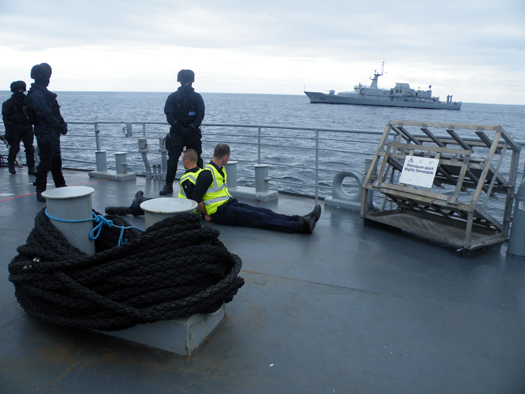
Interdiction party on the aft–deck
Completely dressed in black uniforms including helmets, the teams armed with pistols and truncheons boarded the L.E. Aoife. Two of her crew-members acted as individuals engaged in criminal activity and where led under tight security up to the wheelhouse.
In addition to this high-drama scenario at sea, a casualty winching exercise with an Air Corps AW139 helicopter was carried out at close quarters above the aft-deck of L.E. Samuel Beckett. The helicopter normally based at Baldonnel had flown down to Cork Airport and onward to take part in the exercise.
Also part of the week's exercise where inter-ship replenishments for the transfer of personnel and provisions while naval ships are at sea. This alleviates the necessity for a ship to return to port while on domestic operations and potentially in circumstances where vessels could be deployed on missions overseas.
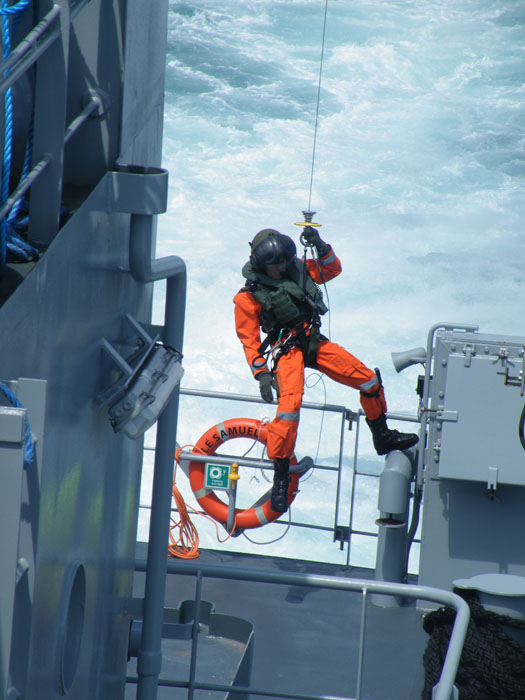
Winch operation
As outlined above the role of the Naval Service is clearly not just about fishery protection duties, in which there has been 407 boardings and four detentions carried out so far this year.
With the L.E. Samuel Beckett in service, the navy and that of her newbuild sisters are better prepared through new operational capability to undertake routine patrols and tasks in an area twelve times the size of Ireland's land mass.
An added efficiency to operations will be Unmanned Aerial Vehicles (UAV) which are planned to be introduced next year. This component in the Naval Service is to enhance in carrying out surveillance operations, among them covert vessel tracking to those dealing with oil-pollution monitoring.
A large area of EU waters (15%) is under Irish sovereign control and are patrolled by the Naval Service current fleet of 8 vessels. Our waters provide an estimated €3.4 billion in resources to the Irish exchequer annually or approximately equate to 1.2% of GDP.
#SamuelBeckett - The State's newest Naval Service patrol vessel opened to the public for the first time (in Cork), and there to greet the arrival was a little girl who welcomed her father home from sea yesterday, writes the Irish Examiner.
Allie O'Connell, 12, from Ballyvolane, gave her father, CPO Phil O'Connell, a huge hug as he stepped off the state-of-the-art LÉ Samuel Beckett, shortly after arriving at Cork's city quays yesterday ahead of its formal twinning ceremony with the city later today.
"It was great to see her," the vessel's coxswain said. "We are in the middle of a four-week patrol and it was great to come up the river and to be welcomed by her. My mother, Bridie, was there too."
Allie and her classmates from Scoil Oilibhéir were due to form a guard of honour on the quayside as part of the twinning ceremonies later today.
For more including footage of her crew boarding the new OPV in Dublin's central quays where as previously reported on Afloat.ie, the €50m OPV was named and commissioned into service in a joint ceremony held last month. Afterwards, the newbuild was opened for the first time ever to the public.
#navy – More great footage from the Irish Air Corps on the Navy's newest ship, LE Samuel Beckett during her recent run up prior to commissioning.
As Afloat reported previously An Taoiseach and Minister for Defence Mr. Enda Kenny, T.D. attended the naming and commissioning ceremonies for the new Naval Service ship, LÉ Samuel Beckett beside the Samuel Beckett Bridge in Dublin city centre. The naming ceremony was carried out by a niece of Samuel Beckett, Mrs. Caroline Murphy. The second ship, James Joyce is to arrive in 2015..
The LÉ Samuel Beckett did some 'interoperability' training with the Air Corps. Airman Terry Healy captured some great footage of Ireland's latest vessel being put through her paces off the south coast and then coming into Dublin on the 16th May for the first time.
RTE Nationwide broadcasts a half hour special on the LE Samuel Beckett this evening (Monday 19th) at 7pm on RTE One.
#navy – Following a tender competition the first of two new ships for the Irish Navy arrived into Dublin for a naming ceremony at the weekend. See time lapse arrival of her arrival up the River Liffey above. As Afloat reported previously An Taoiseach and Minister for Defence Mr. Enda Kenny, T.D. attended the naming and commissioning ceremonies for the new Naval Service ship, LÉ Samuel Beckett beside the Samuel Beckett Bridge in Dublin city centre. The naming ceremony was carried out by a niece of Samuel Beckett, Mrs. Caroline Murphy. The second ship, James Joyce is to arrive in 2015.
The contract for the new ships was signed in October 2010, with Babcock Marine, part of the Babcock International Group, in the United Kingdom for the provision of two new offshore Patrol Vessels (OPVs) for the Naval Service to be built in Appledore, Devon, United Kingdom (same shipyard where both LÉ Roisin and LÉ. Niamh were built over a decade ago).
The new ships are larger vessels than LÉ Roisin and LÉ Niamh with a length of 89.5m.The cost of the two new ships is €108m, exclusive of VAT.
This is a replacement programme – LÉ Samuel Beckett replaces LÉ Emer which was decommissioned and sold late last year. The ship will be used mainly for fishery protection patrols.
LÉ Samuel Beckett arrived home to the Naval Base, Haulbowline, Cork on Wednesday 30th April 2014. The ships first captain is Commander Ken Minehane from Bantry. The ship will have a main crew of 44.
Work on the second ship (LÉ James Joyce) is well advanced and it should be completed early in 2015. LÉ James Joyce will replace LÉ Aoife.
Brief Specification of the LE Samuel Beckett
|
Class of Ship |
Offshore Patrol Vessel |
|
Length |
89.5 metres |
|
Beam |
14 metres |
|
Draft |
3.8 metres |
|
Max Speed |
23 knots |
|
Propulsion |
2 x Wartsila Diesel Engines, 2 shafts, 10000kw |
|
Accommodation |
44 crew plus 10 trainees |
|
Main Weapons |
1 x 76mm Oto Melara Compact Naval Gun 2 x 20mm RH 202 Rheinmetall Cannon 2 x 12.7mm Heavy Machine Gun’s 4 x 7.62mm General Purpose Machine Gun’s
|
#SamuelBeckett- A niece of Samuel Beckett, Caroline Murphy performed the honour of naming the Naval Service's newest OPV, L.É. Samuel Beckett (P61) and at her side An Taoiseach and Minister for Defence Enda Kenny witnessed the customary champagne bottle smash against the bow, writes Jehan Ashmore.
In his address, An Taoiseach said "the naming and commissioning carried with it a great sense of pride and anticipation for all Naval Service personnel. L.E. Samuel Beckett will be a tremendous asset to the Naval Service. I know that the ship's first captain, Commander Ken Minehane and his crew are eagerly looking forward to working up the new ship to its full potential".
The €50m L.E. Samuel Beckett named after the Nobel Prize winning playright, took place along Sir John Rogerson's Quay. Also on the quayside is the statue of the founding father of the Argentine Navy, Admiral William Brown who hailed from Foxford, Co. Mayo. Ahead of the L.E. Samuel Beckett's bow is the Liffey bridge that also bears the same name of the playright.
The appropriate backdrop to the historic occasion included the commissioning of the OPV90 class newbuild into the Naval Service which took place in front of an invited audience as well as the public during glorious conditions.
Among the Government representives was the newly appointed Minister for Justice and officials from shipbuilders, Babcock Marine & Technology, Appledore in north Devon, which floated out the newbuild last November and saw her completed last month as yard no. 194.
The vessel which docked yesterday (see photos), was blessed and following this the L.E. Samuel Beckett's captain, Commander Ken Minehan read out the commissioning warrant to the ship's coy. Then the captain was 'piped' on board the vessel that was officially accepted as a state ship.
L.E. Samuel Beckett – the view from one bridge to another!

Captain Ken Minehan is 'piped' on board
The gangway also saw the ships company (off 44 personnel and 10 more for trainees) embark on the newest member of the Naval Service which has restored an eight-strong fleet follwing the decommissioning of L.E. Emer last year.
A sister of the newbuild, L.E. James Joyce (P62) which is constructed of 55 modular sections before been assembled is due to enter service next year. Together the 'Beckett' class cost €108m and among their primary roles are fishery protection, SAR, drug interdiction and monitoring of pollution incidents. Her main armement is the bow-mounted 76mm OTO Melara gun.
On board L.E. Samuel Beckett is an iconic photograph of the ship's namesake taken at Le Petit Café, Paris, in December 1985. This was Beckett's favourite place to meet his friends. The photographer, John Minihan was also on board to discuss the famous photograph with An Taoiseach, Captain Minehan and Caroline Murphy.
The other branches of the Defence Forces attended the ceremony, the Irish Army and Air Corps which provided a fly-past that tracked above the Liffey quays and involved a CASA Maritime Fisheries Patrol aircraft.
As guests explored the new vessel, the Army No. 1 Band played Adele's soundtrack to the James Bond film 'Skyfall' which all added to the celebratory atmosphere. Tomorrow (Sunday) afternoon, the newbuild will be open to the public between 2 and 5pm.
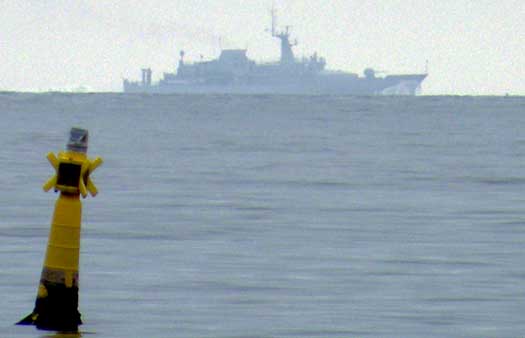
L.E. Samuel Beckett on first patrol after naming ceremony and is seen here off Killiney Bay
L.É. Samuel Beckett’s Commissioning Ceremony to Take Place Close to Iconic Namesake Bridge
#LESamuelBeckett- The newest Naval Service OPV, L.É. Samuel Beckett (P61), the first of a pair of OPV90 class newbuilds, is to be commissioned into service at a ceremony held close to Dublin city's Samuel Beckett swing-bridge on Saturday, writes Jehan Ashmore.
It is fitting that the newbuild which cost €49m is to be commissioned close to the Dublin's most modern bridge that spans the Liffey since its installation in 2009.
Likewise of the navy's namesake newbuild, the swing-bridge arrived to the capital by sea!... having been constructed in the Netherlands was towed on a barge-pontoon and 'floated-in' (see photo) to Dublin Port.
If you are to compare the length of the bridge's span and that of the newbuild OPV, the bridge which was inspired by Santiago Calatrava is 123 metres long while that of the newbuild OPV90 class refers to her 90 metre length.
Public Tours
After completion of official proceedings on the Saturday morning, L.E Samuel Beckett will according to a Naval Service spokesperson speaking to Afloat.ie, be made available for her first public tour.
The inaugural tour is between 2-5pm on Saturday afternoon and repeated during the same hours the next day.
The 'Beckett' class newbuild was 'floated out' from Babcock Marine shipyard in north Devon last November made her delivery voyage to the Naval Base on Haulbolwine last month. She is of a design based from her predecessor the 'Roisin' class and that of STX Marine, Canada.
Notably, she is more than 10m longer in length and has an increased crew compliment of 55, compared to the 44 crew each of older half-sisters, L.E. Roisin and L.E. Niamh.
L.E. Samuel Beckett follows in the wake of L.E. Emer (P21), the veteran OPV that she directly replaced and which berthed opposite the Convention Centre on her final farewell visit to the capital on the occasion of Flightfest. She also made a special cruise in Dublin Bay for former crew members.
The former naval vessel sold to Nigerian interests and she still remains at Cork Dockyard, at a berth outside the dry-dock facility.
#LEsamuelBeckett – L.E. Samuel Beckett (P61) the first of a pair of OPV 90m class newbuilds, each costing €49m, arrived into Cork Harbour this morning, marking a momentous chapter in the history of the Irish Naval Service, writes Jehan Ashmore.
The 90m vessel of almost 2,000 tonnes sailed overnight from Babcock Marine's Appledore shipyard in north Devon, a distance of approximately 145 nautical miles.
However that distance actually refers to her first sight of the Irish coast off Ballycotton, where the east-Cork coastal community last weekend welcomed their very own with the return of the former lifeboat, the RNLB Mary Stanford of Daunt Lightship rescue fame.
L.E. Samuel Beckett, an enhanced 'Roisin' class OPV 80m offshore patrol vessel then made the short coastal passage to round Roches Point Lighthouse, prior to completing her delivery voyage within the natural harbour.
She docked at the Naval Base on Haulbowline, at the foot of the naval headquarters control tower that overlooks the island which has a basin. The basin is not constrained to tides as it has no lock gate, can berth the fleet that has now been restored to the original eight-strong fleet.
Beforehand, the fleet which was one short following the decommissioning of L.E. Emer (P20) last September that took place in Cork city-centre quays marking the end of an era and also the future with her direct replacement.
The newbuild was built on the banks of the River Torridge, where her keel was laid down in May 2012 and two years later L.E. Samuel Beckett is to named at a ceremony on 17 May along Dublin's city-centre quays, close to the Samuel Beckett swing-bridge.
The same building hall at Bidna downriver of Bideford also built L.E. Roisin (P51) in 1999 and L.E. Niamh (P52) in 2001 respectively. Then the yard which was founded in 1855 was owned by Appledore Shipbuilders until it went into administration in 2003.
International global engineering group, Babcock through its marine division brought the yard, and is one of only a handful of facilities remaining in the UK that is capable of building naval ships.
L.E. Samuel Beckett is to have a crew of 54 and she is replacement of L.E. Emer, the oldest unit of the naval fleet, which was built in 1978 at Verolme Cork Dockyard (VCD).
The 'Emer' still remains at the same yard in Rushbrooke, though current owners Cork Drydock carry out repair and maintenance work.
Work on the vessel has taken place to adapt her for a new role as the former leadship 'Emer' class vessel was sold last year to Nigerian shipping interests Uniglobe.
Devon-Built OPV L.E. Samuel Beckett Handed to Naval Service
#LEsamuelBeckett – The first of a pair of newbuild OPV's, the €50m (£41m) L.E. Samuel Beckett (P61) will be handed over to the Irish Naval Service at a Devon shipyard later, reports BBC News.
The 90m (295ft) offshore patrol vessel is the first completed ship to be built at Appledore Shipyard, near Bideford, since 2002.
The Naval Service ordered two vessels from the shipyard (Babcock Marine) in October 2010 for €99m (£81m). The second, to be name James Joyce (P62) is currently under construction. Samuel Beckett will be used for fisheries and coastal protection. For more from the BBC, click HERE to include an amidships photo of the newbuild class.
As previously reported on Afloat.ie, L.E. Samuel Beckett, the OPV 90 leadship or enhanced 'Roisin' class, carried out her shipbuilders sea-trails in the Bristol Channel, which earlier this month for example involved trials included a call offshore of Ifracombe on the North Devon coast and repeated circuits around Lundy Island.
L.E. Samuell Beckett was floated out last November from the builders hall dry-dock for the first time into the River Torridge. Asides her increased length another notable spot the difference, when taken at a glance is the enclosed bulky looking mainmast as distinct to the lattice structure of her predecessors.
It will be interesting see how her sister L.E. James Joyce will appear, should any minor or major design revisions be required when she is due for completion in 2015.
Last week L.E. Roisin (P51) detained a Spanish registered fishing vessel last week for alleged breaches of fishing regulations approximately 100 nautical miles south-west of Mizen Head.



























